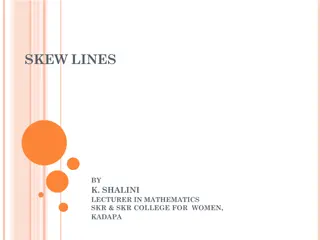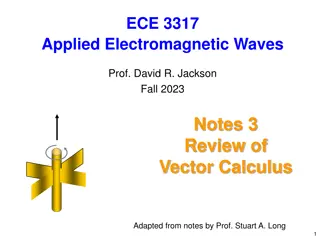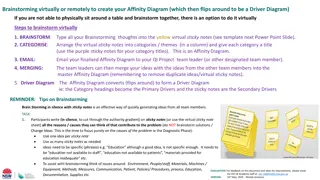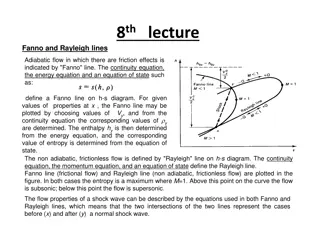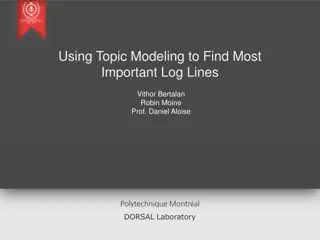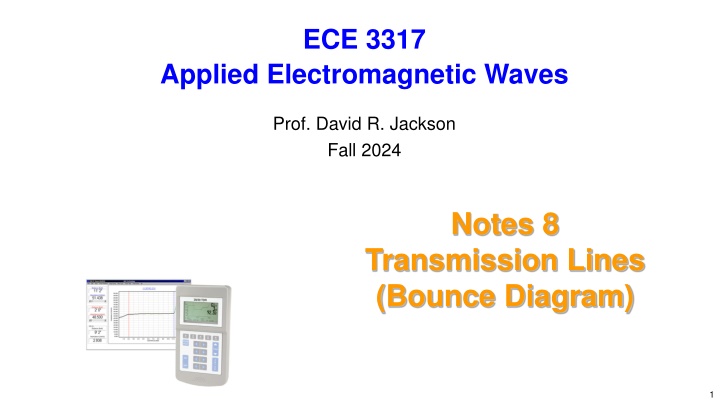
Electromagnetic Waves: Transmission Line Bounce Diagram Explained
Learn how bounce diagrams are used to find step responses on terminated lossless lines, understand the concept through detailed diagrams, the steady-state solution, and practical examples in applied electromagnetic waves with Professor David R. Jackson. Explore the practical application of bounce diagrams for analyzing voltage waves and traces on transmission lines.
Download Presentation

Please find below an Image/Link to download the presentation.
The content on the website is provided AS IS for your information and personal use only. It may not be sold, licensed, or shared on other websites without obtaining consent from the author. If you encounter any issues during the download, it is possible that the publisher has removed the file from their server.
You are allowed to download the files provided on this website for personal or commercial use, subject to the condition that they are used lawfully. All files are the property of their respective owners.
The content on the website is provided AS IS for your information and personal use only. It may not be sold, licensed, or shared on other websites without obtaining consent from the author.
E N D
Presentation Transcript
ECE 3317 Applied Electromagnetic Waves Prof. David R. Jackson Fall 2024 Notes 8 Transmission Lines (Bounce Diagram) 1
Step Response The concept of the bounce diagram is useful to find a step response on a terminated lossless line: t = 0 Lossless line R R L + - g ( ) t Z gv 0 0V V = z L z = 0 u(t) = unit step function V 0 Note: ( ) t gv ( ) ( ) The bounce diagram is useful if the source is a step function or a rectangular pulse (discussed later in these notes). If the source is something else, it is better to use the general theory presented in Notes 7. = gv t V u t 0 t Generator voltage 2
Step Response (cont.) The voltage wave is shown approaching the load: = t = = t t 0 t t dc 2 1 V+ t = 0 R R L + - g ( ) t Z gv 0 1 V V = 0 = z L z = 0 Z + + = 0 V V (from voltage divider) 0 R Z 0 g 3
Bounce Diagram t = 0 R R L + - g ( ) t Z g v 0 1 V V = 0 = z L z = 0 Basic constants g L L c z t = = 0 T 0 V+ d V+ T Z + LV+ + = 0 V V t LV+ The purple values give the total voltage in each triangular region. 0 + (1 ) R Z 2T 0 g LV+ g LV+ + + (1 ) 3T L g + R R Z Z 2 LV+ + + + (1 g = 0 L 2 LV+ ) L 4T L g L g 0 L 2 LV+ 2 g 2 LV+ + + 2 g (1 ) 5T + R R Z Z 3 LV+ 2 g 0 g = g 3 LV+ + + 2 g (1 ) 6T 0 g 4
Steady-State Solution Adding all infinite number of bounces (t = ), we have: + + = + + + + + + + + + 2 g 2 L 3 g 3 L 2 g 2 L 3 g 3 L ( , ) V z (1 ) (1 ) V V g L L g L Sum of all right-traveling waves Sum of all left-traveling waves After some math, we have (please see the Appendix): R + Note: = ( , ) V z V L The steady-state solution does not depend on the transmission line length or the characteristic impedance! 0 R R L g This is the DC circuit-theory voltage divider equation! 5
Example R = t = 225 0 g + - ( ) t Z = R = 75 gv 25 T = V = 1 ns 4 V 0 L 0 = z L z = 0 1 2 1 2 = = g L 0 0 [m] z 1[V] 1[V] Z + 1 1[V] 2 + = = 1 [V] V V 0 0 R Z 0 g 0.5[V] 2 1[V] 4 1[V] 8 1[V] 16 1[V] 32 [ns] t + 1 2 R R Z Z 0.25[V] 3 = = 0 L L + 0 L 0.375[V] 4 + + R R Z Z 1 2 0 g = = 0.4375[V] 5 g 0 g 0.40625[V] 6 1[V] 64 0.390625[V] 6
Example (cont.) The bounce diagram can be used to get an oscilloscope trace of the voltage at any point on the line. 3 4 3 4 = z L = z L 1 2 1 2 = = g L 0 0 [m] z 1[V] 0.75 [ns] 1[V] 1 1[V] 2 1.25 [ns] oscilloscope trace 4( , ) ( ) v L t 3 0.5[V] 2 [ns] t 1[V] 4 1[V] 8 1[V] 16 1[V] 32 2.75 [ns] [V] 1[V] 0.25[V] 3 + 3.25 [ns] 0.375[V] 0.5[V] 4 0.4375[V] 0.375[V] + 4.75 [ns] 0.4375[V] 5 0.25[V] 2 3 0.40625[V] 1 4 5 6 1[V] 64 [ns] t 0.390625[V] R + Steady state voltage: = = ( , ) v z 0.400 [V] V L 0 R R L g 7
Example (cont.) 3 4 = Final oscilloscope trace of the voltage at z L t = 0 + ( ) t Z gv R V = 4 V 0 L 0 - = z L = z = 0.75 z L 0 1[V] 0.5[V] 0.375[V] 0.4375[V] 0.25[V] 2 3 1 4 5 [ns] t 8
Example (cont.) The bounce diagram can also be used to get a snapshot of the line voltage at any point in time. t= 3.75 ns ( , 3.75[ns]) v z ( ) snapshot [V] Wavefront is moving to the left L/4 0.375[V] t= 3.75[ns] 0.25[V] L L 3 L L 4 2 4 [m] z 9
Example (cont.) This set of snapshots shows the waves bouncing back and forth. Initial wave First reflected wave 1 2 = L 1.0 V 1.0 V 0.5 V 1.0 V 1.0 V 0.5 V 1.0 V 1.0 V 0.5 V 1.0 V 0.5 V 10
Bounce Diagram for Current = I We just change the signs of the reflection coefficients, as shown. 1 2 1 2 = = I g I L Normalized Current 0 ( ( ) ) , , i i L t L t 0 1 = [m] z I L + 1 1 1 2 Z + + = = 1 [V] 0 V V ( )( )( , , L t ) , 1/ 1/ v L t L t Z 0 1.5 R Z 2 = 0 0 g [ns] t 1 4 ( ) + , v Z 0 1.25 + 3 V A 1 8 += ( ( ) ) I v v L t Z = 4 1.125 0 + 1 16 1.1875 5 + + + = = = = N 1 [V] I Z I V 1 32 L 0 0 1.21875 6 1 64 1.203125 Note: The normalized current iN(z,t) is defined as Z0i(z,t). 11
Example for Current Oscilloscope Trace for Current 3 4 = z L Normalized Current 3 4 1 2 1 2 = = = I g z L I L 4( , ) Z i L t 3 0 ( 0 oscilloscope trace of current) 0 1 0.75 [ns] [m] z 1 1 1 2 1.25 [ns] 1.5 1.5 2 [ns] t 1 4 1.25 1 1.125 1.1875 1.25 3 2.75 [ns] (units are volts) 1 8 3.25 [ns] 4 1.125 1 16 1.1875 4.75 [ns] 5 2 3 1 4 5 1 32 [ ] t ns 1.21875 6 1 64 1.203125 V + ( )( ) = = Steady state current: 0( , ) Z i z = = ( , ) i z 0.016 [A] 0 0.016 75 1.20 V R R L g 12
Example for Current (cont.) t= 3.75 ns Snapshot for Current 0( , 3.75[ns]) Z i z (snapshot of current) 1 2 1 2 = = I g I L Normalized Current 0 Wavefront is moving to the left 0 1 [m] z 1 1 1.25 1 2 1.125 1.5 2 [ns] t 1 4 (units are volts) 1.25 3 1 8 L/4 4 1.125 L L 3 L 1 t= 3.75[ns] L 16 4 2 4 1.1875 5 1 32 [m] z 1.21875 6 1 64 1.203125 13
Two Transmission Lines Here we have a reflection and transmission coefficient at the junction between two lines. Junction R = 225 t = 0 T = T = g 1 ns 1 ns + - ( ) t Z = R = V = Z = 150 50 gv 4 V 75 0 L 0 0 z = = 0 z L 75 150 225 1 3 150 75 225 1 3 J T+ + = = = = Note: J J + When the wave first hits the junction, it sees the characteristic impedance of the line on the other side as a load. J 4 3 2 3 + + J T = + = = + = 1 T 1 T J J J J J KVL: TJ = 1 + J (This follows from the fact that voltage must be continuous across the junction.) 14
Two Transmission Lines (cont.) Bounce Diagram for Two Lines Junction R = 225 t = 0 T = T = g 1 ns 1 ns + - ( ) t Z = R = V = Z = 150 gv 50 4 V 75 0 0 L 0 = z L z = 0 1 3 2 3 4 3 + T+ = = J J 1 3 = = JT J 1 2 1 2 = = g L 0 1[V] 0[V] 0[V] [m] z 1[V] 1 0.3333[V] 1.3333[V] Note: 1.3333[V] 1.3333[V] 2 The magnitude of a transmission coefficient can be larger than 1! [ns] t 0.6667 [V] 0.1667[V] 1.5000[V] 0.6667 [V] 3 0.2222 [V] 0.2222 [V] 0.4444 [V] 0.0555[V] -0.4444 [V] -0.3888 [V] 4 1.1111[V] 1.1111[V] 15
Pulse Response Superposition can be used to get the response due to a rectangular pulse. R g + - ( ) t ( ) t Z R +- gv gv 0 L z = = 0 z L ( ) ( ) t ( ) ( ) = V gv V u t u t W 0 0 ( ) t u(t) = unit step function gv 1.0 ( ) u t t t W We thus subtract two bounce diagrams, with the second one being a shifted version of the first one. 16
Example: Pulse Find an oscilloscope trace of the voltage at z = 0.75 L R = Oscilloscope trace 225 g ( ) t R = 25 Z = +- 75 T = 1 ns gv L 0 = z L z = 0 = 0.75 z L Given pulse: V+ = = 4 V 1[V] V V = 4 V 0 0 ( ) gv t Z + W = 0.25 ns + = = Recall : 1 [V] V V 0 0 R Z 0 g t W 17
Example (cont.) Oscilloscope trace for original step function ( ) 3 4 = z L [V] 1[V] 1 2 1 2 = = g L 0.5[V] 0 0.4375[V] 0.375[V] 0 [m] z 1[V] 0.75 [ns] 1[V] 1 1[V] 2 0.25[V] 1.25 [ns] [ns] t 2 3 1 4 5 0.5[V] 2 [ns] t 1[V] 4 1[V] 8 1[V] 16 1[V] 32 2.75 [ns] [V] 0.25[V] 3 + 3.25 [ns] Subtract 0.375[V] 4 Shifted trace + 4.75 [ns] [V] 1[V] 0.4375[V] 5 (shifted by W =0.25 [ns]) 0.5[V] 0.4375[V] 0.40625[V] 6 0.375[V] 1[V] 64 0.390625[V] 0.25[V] [ns] t 2 3 1 4 5 18
Example: Pulse (cont.) V V = 4 V 0 0 ( ) gv t W = 0.25 ns t W R = Oscilloscope trace 225 g ( ) t R = 25 Z = +- 75 T = 1 ns gv L 0 = z L z = 0 = 0.75 z L 4( , ) v L t 3 1[V] Oscilloscope trace of voltage Incident pulse sweeping past the oscilloscope 0.125[V] 0.0625[V] Reflected pulse sweeping past the oscilloscope [ns] t 2 3 1 4 5 0.03125[V] Re-reflected pulse (reflected from the generator) sweeping past the oscilloscope 0.25[V] 0.5[V] 19
Example (cont.) Final oscilloscope trace of the voltage at 3 4 = z L 5 + ( ) R Z gv t - L 0 z = 0 = z L = 0.75 z L 1[V] 4( , ) v L t 3 0.125[V] 0.0625[V] [ns] t 2 3 1 4 5 0.03125[V] 0.25[V] 0.5[V] 20
Example: Pulse (cont.) Find a snapshot of the voltage at t = 1.5 [ns]. R = 225 g ( ) t R = 25 Z = +- 75 T = 1 ns gv L 0 = z L z = 0 t = 1.5 ns V = 4 V V+= 1[V] 0 ( ) gv t W = 0.25 ns t W 21
Example: Pulse (cont.) Shifted numbers Original step Delayed step 1 2 1 2 = = 1 2 1 2 L = = g L g 0 0.25 nS 0.25 0 1[V] 0 [m] z 1[V] 1[V] 1 1[V] 2 L / 2 1[V] 1.25 1[V] 2 3L / 4 0.5[V] 2 0.5[V] 2.25 1[V] 4 1[V] 8 1[V] 16 1[V] 32 [ns] t 1[V] 4 1[V] 8 1[V] 16 1[V] 32 0.25[V] 3 0.25[V] 3.25 + + 0.375[V] 4 0.375[V] 4.25 + + 0.4375[V] 5 0.4375[V] 5.25 0.40625[V] 6 1[V] 64 0.40625[V] 6.25 1[V] 64 0.390625[V] 0.390625[V] 22
Example: Pulse (cont.) Snapshot from original step function V 1.0 0.5 [m] z 0.25L 0.5L L 0.75L Subtract V Snapshot from shifted step function 1.0 0.5 [m] z 0.25L 0.5L L 0.75L 23
Example: Pulse (cont.) V V = 4 V 0 Snapshot 0 ( ) gv t W = 0.25 ns t W R = 225 g ( ) t R = 25 Z = +- 75 T = 1 ns gv L 0 = z L z = 0 Snapshot of voltage ( ,1.5[ns]) v z 0.25L 0.5L 0.75L L [m] z Pulse is moving to the left (after being reflected from the generator). 0.5[V] 24
Capacitive Load = R Z t = 0 0 g C L + - ( ) t Z gv 0V V 0 = z = z L 0 Note: The generator is assumed to be matched to the transmission line for convenience (we wish to focus on the effects of the capacitive load). = 0 Hence g The load reflection coefficient L is now a function of time. 25
Capacitive Load (cont.) ( )/ = = ( L z t c d d dt ) dt delay = R Z t = 0 0 g C L + - ( ) Z gv t 0V V 0 = z = z L 0 z (time = t) ( ) = 0 Z + Lt + = g V V 0 z 0 R Z t = 0 0 g 0 V+ = 0/2 V V+ T t ( ) t t V+ L d 2T += 0/ 2 V V ( ) ( ) V+ + t t 1 L d 3T 26
Capacitive Load (cont.) = R Z t = 0 0 g C L + - ( ) Z gv t 0V V 0 = z = z L 0 ( ) = At t = T: Thecapacitor acts as a short circuit: 1 LT ( ) 1 = At t = : Thecapacitor acts as an open circuit: L Between t= Tandt = , there is an exponential time-constant behavior. General time-constant formula: Hence, we have: ( ) ( ) + ( ) ( ) ( )/ t T = ( ) ( )/ F t F F T F e t T 1 2 = , Lt e t T t T = Z C 0 L 27
Capacitive Load (cont.) += 0/ 2 V V Assume z = 0 = R Z t = 0 0 g C + L + - ( ) ( ) 0, v t Z gv t 0V V 0 - = z = z L 0 ( ) = 0 V 0 Lt Steady-state (v(t) = V0) ( V e g t = 0 ) 0 V+ z ( ) 2 / t T 01 V+ ( ) T 0, v t t ( ) Lt T V+ 0/2 V 2T ( ) ( ) + + t T 1 V L 3T z = 0 t T 2T ( ) ( ) ( ) ( ) t ( ) ( ) ( ) ( ) ( ) + / 2 / 2 / t T t T t T 1 2 = + t T = + t T = , 1 2 1 , 1 1 e e V V e 0 L L L 28
Inductive Load = R Z t = 0 0 g + - ( ) t L L Z gv 0V V 0 = z = z L 0 ( ) 1 = At t = T: inductor acts as an open circuit: LT ( ) L = At t = : inductor acts as a short circuit: 1 Between t= Tandt = , there is an exponential time-constant behavior. ( ) ( )/ t T = + 1 2 , Lt e t T Recall: ( ) ( ) + ( ) ( ) ( )/ t T = F t F F T F e = / L L Z 0 t T 29
Inductive Load (cont.) += 0/2 V V Assume z = 0 = R Z t = 0 0 g + + - ( ) t ( ) L L Z gv 0, v t 0V V 0 - = z = z L 0 0 V ( ) = 0 Lt g t = 0 ( ) 2 / t T V e 0 V+ ( ) z 0 0, v t V+ 0/2 V T t ( ) Lt T V+ 2T ( ) ( ) V+ + 1 Lt T 3T Steady-state (v(t) = 0) z = 0 t T 2T ( ) ( ) t ( ) ( ) ( ) ( ) ( ) + / 2 / 2 / t T t T t T = + + t T = + t T = 1 2 , 1 2 , 1 e e V V e 0 L L L 30
Time-Domain Reflectometer (TDR) This is a device that is used to look at reflections on a line, to look for potential problems such as breaks of other types of faults on the line. The 20/20 Step Time Domain Reflectometer (TDR) was designed to provide the clearest picture of coaxial or twisted pair cable lengths and to pin-point cable faults. AEA Technology, Inc. 31
Time-Domain Reflectometer (cont.) = dt 2 / t z c round - trip time down to fault) ( d F d = R Z t = 0 = 0 g z z F + - ( ) t = R Z gv Z 0V V Z 0 L 0 0 = z L z = 0 Fault = The fault is modeled as a load resistor at : R z z R F F F The fault might be acting as a parallel resistor or a series resistor. R Z R Z or = 0 0 F F 2 / t z c d F d = R Z t = 0 = 0 g z z F + - ( ) t gv Z 0V V R 0 F z = 0 32
Time-Domain Reflectometer (cont.) dt = 2 / t z c round - trip time down to fault) z ( = d F d R Z t = 0 = 0 g z F + - ( ) t = R Z gv Z 0V V Z 0 L 0 0 = z L z = 0 Fault = The fault is modeled as a load resistor at . R z z = = Short on line: Break on line: 0, R R F F F F ( ) ( ) 0, v t 0, v t = t t d = t t The time tdindicates where the fault is. d t t Resistive load, RF > Z0 Resistive load, RF < Z0 33
Time-Domain Reflectometer (cont.) The TDR can also tell us what kind of a load we have at the end of a line. = R Z t = 0 0 g + - ( ) t Load gv Z 0V V 0 = z L z = 0 ( ) 0, v t ( ) 0, v t t t Inductive load Capacitive load 34
Appendix: Steady-State Solution Adding all infinite number of bounces (t = ) for the step response, we have: + + = + + + + + + + + + 2 g 2 L 3 g 3 L 2 g 2 L 3 g 3 L ( , ) V z (1 ) (1 ) V V g L L g L Sum of all right-traveling waves V + Sum of all left-traveling waves + + + (1 1 ) V + = = V L L Note: We have used 1 1 g L g L g L 1 + + R R Z Z Z Z = n + z 1 0 L 1 1 z Z + = 0 n = 0 L V 0 ( ) 0 + R Z R R + z R R Z Z 0 g 0 g 1 0 L 0 0 g L + R R Z Z + ( )( ) + + + 1 R Z R Z 0 L 0 0 g L Z + = 0 L V 0 ( )( ) ( )( ) 0 R Z R Z R Z R Z R Z 0 g 0 0 0 0 g L g L 35
Appendix: Steady-State Solution (cont.) Simplifying, we have: + + R R Z Z + ( )( ) + + + 1 R Z R Z 0 L 0 0 g L Z + = 0 L ( , ) V z 0 V ( )( ) ( )( ) 0 R Z R Z R Z R Z R Z 0 g 0 0 0 0 g L g L 2 R + ( )( ) + + R Z R Z L Z R 0 0 g L R Z + = 0 L 0 V ( )( ) ( ( ) ( 0 2 L R Z V Z ) ( 0 )( ) 0 + + R Z R Z Z R Z R Z 0 g 0 0 0 0 g L g L ) + 2 + R R Z Z + 0 L g = 0 V ( )( )( ) 0 + R Z R Z R Z R Z R Z 0 g 0 0 0 g L g L = 0 0 ( ) )( ( ) + + R Z R R Z R Z 0 0 0 g L g L 2 R Z V = 0 R R 0 L + + + + + 2 0 2 0 R R Z R Z R Z Z R Z R Z 0 0 0 0 g L L g g L L g 2 R Z V R Z =+ 0 0 L + + + R Z R Z R Z 0 0 0 0 L g L g 36
Appendix: Steady-State Solution (cont.) Continuing with the simplification: 2 R Z V + = ( , ) V z 0 0 R Z L + + R Z R Z R Z 0 2 0 0 0 L g L g R Z V R Z = 0 0 R Z + L ( ) 2 0 0 L R Z V R Z g = 0 0 R Z + L ( ) 0 0 L R V R g = 0 R L + ( ) L g Hence we finally have: R + = ( , ) V z V L 0 R R L g 37






